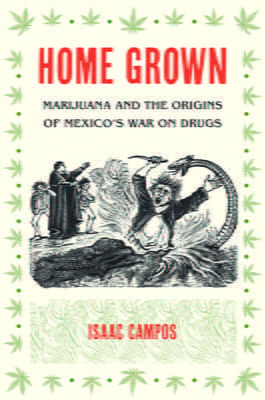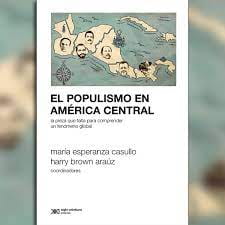A Review of Home grown Marijuana and the Origins of Mexico’s War on Drugs
Tracing Back Marijuana Stigma

Home grown. Marijuana and the Origins of Mexico’s War on Drugs By Isaac Campos The University of North Carolina Press, Chapel Hill, 2012
Marijuana is the talk of the town, as it has recently been discovered to be innocuous. Researchers have encountered little (if any) medical proof of severe health problems caused by its consumption. The idea of marijuana as an “entry drug” that facilitates the consumption of other, more damaging illegal substances has been mostly debunked. Indeed, marijuana consumption seems to be correlated with higher, rather than lower, income and status.
The more is known about marijuana, the more its reputation enjoys an extreme make over. A positive one. Changes in the social perception of marijuana have taken place not only because of marijuana’s relatively safe nature, but because of the objectively high costs of its prohibition. In just a few decades, marijuana has gone from being perceived as a clearly damaging substance (one whose eradication was well worth the cost of a billion-dollar drug war) into one of the many recreational drugs that society is willing to tolerate.
As marijuana rapidly becomes less stigmatized, many questions start begging for answers. When did marijuana’s bad reputation first start? When did a substance for which no clear evidence of damaging effects had been empirically proven turn into an illegal drug deserving international prosecution?
Home Grown, the most recent book by Isaac Campos, offers these and many more answers.
Campos deeply explores the origins of marijuana prohibition to show that the “war against drugs” did not start when President Nixon formally declared it in 1971. Instead, prohibition gestated well before, in the legal and ideological roots of marijuana stigmatization, which can be traced back to the colonial era in Mexico. Ironically, Campos shows that a war on drugs that is commonly perceived to be the result of U.S. pressure into policies enacted south of the border is, in fact, the result of Mexico’s popular beliefs traveling into the United States.
The argument that Campos makes is sound and simple. The origins of the war against drugs lie in the ideological conception that marijuana is dangerous. Such beliefs first emerged in Mexico, linking the substance to violence and madness. The United States adopted the Mexican narrative, stigmatizing marijuana consumption and eventually conducting a militarized war against the substance.
Overall, Campos’s text shows that marijuana was stigmatized not because its effects were particularly pernicious but because it was linked to negatively perceived groups such as prisoners and indigenous people. The effects of marijuana were not different from alcohol. Smoking was even less common than drinking. The real problem was that marijuana was linked to indigenous herbalism and oriental traditions, typically perceived as activities that undermined modernity and development. Furthermore, marijuana was said to be consumed by to prisoners as a stimulant that brought its “savagery to the surface” (pg. 152). The author argues that the origin of the war on drugs does not come from marijuana’s health effects but from the stigma that surrounded those who used it at an earlier time.
Campos draws on a diversity of historical sources to sustain his claims. As his main source of evidence, the author analyzes 600 newspaper articles (extracted from a survey of 40 thousand issues) from more than a dozen publications that discuss marijuana. The information is filtered and organized into basic descriptive statistics like the distribution of news coverage by newspapers from 1878 to 1920, the frequency of marijuana references, the geography of marijuana use, and even the demographic characteristics of marijuana users and effects as reported by the press.
The story starts around the 16th century, when in 1550 Pedro Quadrado, a conquistador, first introduced marijuana into Mexico. Back then it was considered a strong fiber, used as hemp for various products. Yet marijuana soon started to be used as a drug and, by the 18th century, it was clearly linked to indigenous traditions, used for divinatory purposes and to produce visions or supernatural encounters.
Because of its effects, marijuana became associated with madness and violence. It was pretty much accepted that marijuana produced severe mental illness and promoted physical violence among those who used it. Interestingly, despite the many similarities between “marijuana delirium” and that produced by other substances like alcohol, the former was frequently distinguished as being especially pernicious.
Both social discourse and literature commonly associated marijuana with negative outcomes. Campos uses extracts from classic Latin American novels like Los Bandidos del Río Frío by Manuel Payno and El Periquillo Sarniento by José Joaquín Fernández de Lizardi to show how in Mexico’s daily life, the use of marijuana was linked to soldiers, prisoners and other low elements. For literature lovers, the book provides a delightful compendium of quotes and references from the works of accomplished authors, such as Antonio Salinas y Carbo, José Posada, Federico Gamboa and Heriberto Frías, to Guillermo Prieto, José Juan Tablada, Porfirio Barba Jacob and even Emile Zola and Rubén Darío.
Even Mexico’s 19th–century liberals stigmatized marijuana, the author argues, as a form of political opposition against Porfirio Díaz’s dictatorship (1876-1911). They claimed that the reason why marijuana was used in prisons was because of brutal living conditions. Such conditions were a symbol of “all that was wrong with Díaz’s regime” (pg. 143) and its institutional corruption. As a result, liberals portrayed marijuana as one of the many negative consequences indirectly linked to the dictatorship.
Home Grown is a historical book par excellence. It is an academic exercise that finds its evidence in literature, narratives and stories carefully gathered by Campos. The author craftily uses these sources to transport the reader from Mexico’s colonial period to U.S. prohibition era. At times, the book is a statistical analysis of journalistic sources. At other moments it feels like a captivating trip into a Latin American literature class. Most of the time it is just a passionate description of Mexico’s daily life, customs and traditions.
Indeed, for those who are not historians or academics, the book may occasionally be arid. The deeply academic nature of Home Grown makes it an interesting but difficult reading, sometimes too detailed for a person who does not want to become an expert in the topic. It contains a hundred pages of references, footnotes and appendices, most of them only nuances and revisions of what is being described in the main text. Furthermore, chapters feel somehow disconnected. Statistics and charts presented early in the book are never referenced again when evidence is being described. A postscript about how Mexico’s ideas were transmitted to the United States feels unfinished and less well referenced than others. The first chapter, a literature review of marijuana’s health effects, feels superficial and outdated.
Home Grown is an excellent analysis of the historical perceptions of marijuana and an indispensable lecture for those trying to understand the cultural roots of prohibition. It explores the right topic at the right moment.
Winter 2015, Volume XIV, Number 2
Viridiana Ríos has a Ph.D. in Government from Harvard University and is the CEO of México ¿Cómo Vamos? a think tank based in Mexico City.
Related Articles
A Review of Aaron Copland in Latin America: Music and Cultural Politics
In Aaron Copland in Latin America: Music and Cultural Politics, Carol Hess provides a nuanced exploration of the Brooklyn-born composer and conductor Aaron Copland (1900–1990), who served as a cultural diplomat in Latin America during multiple tours.
A Review of El populismo en América Latina. La pieza que falta para comprender un fenómeno global
In 1946, during a campaign event in Argentina, then-candidate for president Juan Domingo Perón formulated a slogan, “Braden or Perón,” with which he could effectively discredit his opponents and position himself as a defender of national dignity against a foreign power.
A Review of Born in Blood and Fire
The fourth edition of Born in Blood and Fire is a concise yet comprehensive account of the intriguing history of Latin America and will be followed this year by a fifth edition.




